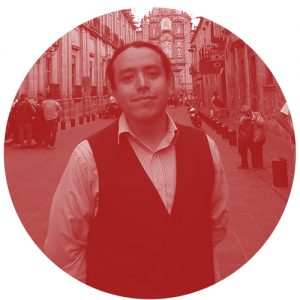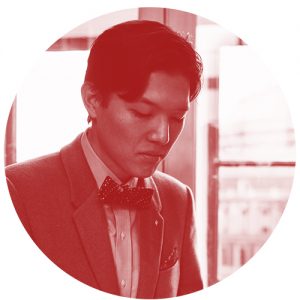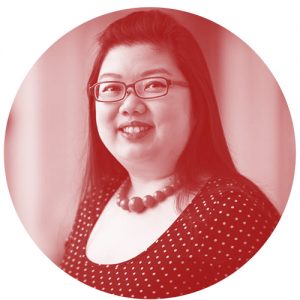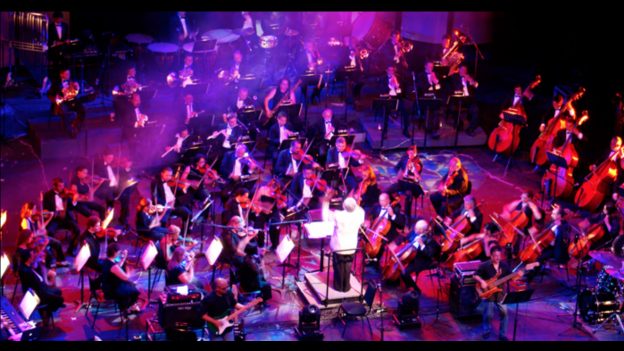August 12-14, 2019 (Aguascalientes, Mexico)
Participant Composers and Works:
Juan José Bárcenas, La muerte Camina (Los murmullos)
Jiyoun Chung, Scissors
Mario Duarte, Metztli-tliltic (La luna negra)
Kenichi Ikuno, Retratos de la locura
Emily Koh, After Igor
Piyawat Louilapprasert, Light and Flame
Program:
American Composers Orchestra seeks to identify and celebrate emerging American composers through its EarShot program.
Drawing from a national network of advisors and advocates, EarShot works with orchestras around the country to identify and support promising composers in the early stages of their careers. Orchestras have relied on EarShot to identify and connect with composers consistent with their artistic vision, and to advise the orchestra on commissions, competitions, and program design. Managed by the American Composers Orchestra (ACO), EarShot is a partnership between the ACO, League of American Orchestras, American Composers Forum, and New Music USA. Over the past 10 years EarShot has initiated dozens of composer/orchestra/conductor relationships across the country offering opportunities to more than 100 composers. In 2016, ACO launched a composer archive of past EarShot compositions now in the orchestral repertoire.
In keeping with ACO’s commitment to customizing the EarShot residencies to the participating orchestra’s programming requests, Aguascalientes Symphony Orchestra will select 3 Mexican composers and 3 American composers for their residency.
This year, the Aguascalientes Symphony Orchestra participant composers will work closely with mentor composers Gabriela Ortiz, Derek Bermel, and Lowell Liebermann, as well as conductor Jose Arean.
SELECTED COMPOSERS
Juan José Bárcenas (Querétaro, Mexico)

Composer and multimedia-sound artist Juan José Bárcenas (he/him) was born in Santiago de Querétaro, Mexico. He started studying composition n 1990 with Dr. Felipe De las Casas, Dr. Mauricio Beltrán Miranda, and Dr. Ignacio Baca-Lobera. He has created more than 50 works, including chamber orchestral, electro-acoustic, film, multimedia, animation, and electronic improvisation. His work is characterized by extreme fluctuation in sound. He currently lives in the city of Santiago de Querétaro and works as an electronic performer, composer, sound engineer and multimedia artist. Since 2006, he has taught composition, harmony, counterpoint and audition training at CEDART “Ignacio Mariano de las Casas” and CUCM-UAQ (University Center for Musical Creation), which he founded in 2018 together with the artist collective INTERCICLOS. His music has been released internationally on multiple labels, including Luna Negra Records and NEOS-Germany.
Juan José’s Sound: El baile de los famas
About La muerte Camina (Los murmullos)
Juan José Bárcenas’ Full Bio
Jiyoun Chung (Kansas, USA)

Jiyoun Chung (she/her) is a native Korean pianist and composer. Since she moved to the USA in 2008, her pieces have been performed at festivals and concerts such as the 2019 String Quartet Smackdown V, the 2019 Music by Women Festival at Mississippi University for Women, the 2019 Women Composer Festival of Hartford, the 2019 College Music Society International Conference in Brussels, Ghent, and Bruges, Belgium, the 2015 Singapore Asian Composers Festival, the 2014 Graduate Association of Music and Musician at University of Texas-Austin, and the 2014 Red Note Festival. She was a finalist in the 2014 PUBLIQ Access competition and the 2014 Birmingham New Music Festival, a semifinalist in The American Prize in 2013 and 2014, and she also received honorable mention in the Rebecca Sherburn Composition competition.
Jiyoun’s Sound: Arirang Fantasie (Performed by Invoke)
About Scissors Scissors for Orchestra is an extension of this attempt to experiment. I was inspired by the Scissors Dance, a Korean traditional dance performed by taffy sellers in farmer’s markets to attract attention from people. The dancers use a special type of scissors to cut the taffy as well as to create percussive sound while performing the rhythmical dance. The dance tends to be showy and dynamic in nature. For example, the dancers throw the scissors high up in the air, spin themselves around, and catch them. Also, to create musically exhilarated sound, the dancers employ Jangdan, a Korean traditional rhythmic mode. Throughout the piece, I did not necessarily intend to be either illustrative or programmatic. Rather, I see this piece as an aural re-interpretation and imagination of the original inspiration. However, I did try to highlight both visual and auditory characteristics of the dance. Jangdan, the array of different, repeated rhythmic patterns, affects in division and progression of the rhythm throughout the piece while acting as a structural framework. Also, I aim to bring out the percussive and metallic nature of the instrument, scissors, by using various percussion instruments. Fast runs will also bring up the image of the scissors thrown in the air. The pitch material is broadly atonal, yet the progressions are mostly linear to be more accessible. I hope the listeners relate to the energetic and vigorous atmosphere while enjoying rhythmic drive with lively gestures.
Jiyoun Chung’s Full Bio Jiyoun Chung received her Bachelor’s in Composition from Hanyang University in South Korea. She earned her Master’s degree both in Composition and in Piano Performance from Illinois State University, studying with Carl Schimmel and Martha Horst. She received the Doctor of Musical Arts in composition at the University of Missouri-Kansas City, where she studied with Chen Yi, Zhou Long, and James Mobberley.
Mario Duarte (Michoacan, Mexico)

Dr. Mario Duarte (he/him) was born in Mexico City. After completing his studies in classical guitar, musicology and composition in his country, he travelled to the UK to complete a master’s degree and a PhD under the supervision of Ricardo Climent at NOVARS Research Centre, The University of Manchester. Mario completed a postdoctoral research fellow in Music Technology at The National Autonomous University of Mexico and CMMAS under the supervision of Rodrigo Sigal. He is a composer interested in the crossover between Science, Literature and Pre-Columbian cultures. His music has been played in major festivals in Mexico, Europe and the UK at Huddersfield Contemporary Music Festival and New Music North West. He has worked as a producer and scriptwriter of contemporary music broadcasts at Opus 94.5 FM Instituto Mexicano de la Radio (2009) and as a music teacher IB MYP (2011-12).
Mario’s Sound: Excerpt from Contraelegia
About Metztli-tliltic (La luna negra)
Mario Duarte’s Full Bio
Kenichi Ikuno (Mexico City, Mexico)

Kenichi Ikuno Sekiguchi (he/him) is a Mexican composer of Japanese heritage who was born and raised in Mexico City. He received his Bachelor’s degree in Composition at Mannes College of Music in New York City, studying with Rudolph Palmer and David Tcimpidis. He was later admitted into the Master in Music degree in Composition from the Royal College of Music, London studying with Kenneth Hesketh. He has participated in masterclasses with Derek Bermel, Uri Caine and Lowell Lieberman in New York City, David Conte and Philip Lasser in Paris, and with Mark-Anthony Turnage in London. His opera, “76 Days,” was premiered in the Britten Hall in London produced by the Royal College of Music in partnership with Tête à Tête Opera under the direction of Bill Bankes-Jones. He has been commissioned to write works for Rie Watanabe, aTonalHits and the Fukio Saxophone Quartet. In 2016, he was awarded a grant from the Mexican Ministry of Culture for young artists (beca FONCA de Jóvenes Creadores) to compose a piece under the tutelage of Marcela Rodríguez and Lilia Vázquez-Kuntze. His piece “Vox Villaurrutiensis” was recorded by aTonalHits for their album “Origins.” Ikuno’s pieces have been performed in various cities in the United States, as well as in London, Mexico City, Hong Kong, Tainan, and Paris.
About Retratos de la locura As the title of the piece suggests, it is an imaginary portrait of a person with dissociative identity disorder – hence the constant and sudden changes of mood and character. The instability and lack of structure are intentional. Writing a fugue in the present times seems almost an act of outmoded foolishness, but paraphrasing Steve Reich “good ideas tend to be old.” So I did not resist the temptation to compose a fugue when I had the idea for this piece. It is by no means a strict fugue, but it does use some fugal techniques like stretti, augmentation, diminution, inversion, false entries, etc. The subject derives from the opening and closing part of the first section, but it is expanded to become the subject. Threequarters of the way into the fugue, the subject is inverted and drives into a brief ascending coda.
Emily Koh (Georgia, USA)

Emily Koh (she/her) is a Singaporean composer and double bassist based in Atlanta, whose music is characterized by inventive explorations of the smallest details of sound. In addition to writing acoustic and electronic concert music, she enjoys collaborating with other creatives in projects where sound plays an important role in the creative process. Described as ‘the future of composing’ (The Straits Times, Singapore), she is the recipient of awards such as the Yoshiro Irino Memorial Prize, ASCAP Morton Gould Young Composer Award, Prix D’Ete, and PARMA competitions, commissions from the Barlow Endowment for Music Composition, Composers Conference at Wellesley College, Singapore Symphony Orchestra, Left Coast Chamber Ensemble, Dinosaur Annex Music Ensemble and grants from New Music USA, Women’s Philharmonic Advocacy and Paul Abisheganaden Grant for Artistic Excellence. She has been a fellow at the MacDowell Colony and Avaloch Farm Music Institute.
Emily’s Sound: Emojicons, Movement 1 (Performed by Departure Duo)
About After Igor
Emily Koh’s Full Bio
Piyawat Louilapprasert (New York, USA)

Piyawat Louilarpprasert (he/him), “the rebel Thai composer taking music to unheard heights” (CNN News World) writes works that explore possibilities of creating the amalgamation of sonic and visual arts; including integrating multimedia and music, deconstructing instruments’ mechanism and physicality with sound production method, and involving Thai traditional music elements in new compositions. Louilarpprasert’s compositions have been performed in MUSIIKIN AIKA – Time of Music 2018 (Finland), Saint Petersburg New Music Festival 2018 (Russia), Lucerne Festival 2016 (Switzerland), Gaudeamus Musikweek 2016 (Netherlands), China – ASEAN Music Week 2016 (China), Darmstadt New Music Festival 2014 (Germany), among others. He collaborated with established ensembles and orchestras such as Arditti Quartet, Switch Ensemble, Meitar Ensemble, International Contemporary Ensemble, Lucerne Alumni Ensemble, Ensemble Surplus, Ensemble Mozaik, Royal Northern Sinfonia, RCM Philharmonic Orchestra and Thailand Philharmonic Orchestra.
Piyawat received several arts and composition prizes such as Matan Givol Prize 2019 (Israel), ASCAP Morton Gould Young Composer Award 2018, KulturKontakt resident artist 2017, the Charles Stewart Richardson Award (RCM, UK), The Otto R. Stahl Memorial Award 2018 (USA), Sergei Slonimsky Composition Award 2018 (Russia), Minnesota Orchestra Composer Institute 2019 (USA, runner-up), Luzern Festival Composer Seminar (Switzerland), Gabriel Prokofiev Nonclassical (UK), Léon Goossens Prize 2016 (UK), Young Thai Artists Awards 2013 and many more. He is currently a doctoral candidate in composition at Cornell University, Ithaca, New York with Kevin Ernste and Marianthi Papalexandri Alexandri. His mentors were Valeriy Rizayev, Dai Fujikura, Jonathan Cole and Gilbert Nuono.
Piyawat’s Sound: Silhouette for piano trio, Movement 1
About Light and Flame
COMPOSITORES SELECCIONADOS
Juan José Bárcenas (Querétaro, Mexico)

El compositor y artista de sonido multimedia Juan José Bárcenas nació en Santiago de Querétaro, México. Comenzó a estudiar composición en 1990 con el Dr. Felipe De las Casas, el Dr. Mauricio Beltrán Miranda y el Dr. Ignacio Baca-Lobera. Ha creado más de 50 obras, incluyendo música de cámara, orquesta, electroacústica, cine, multimedia, animación e improvisación electrónica. Su obra se caracteriza por una fluctuación extrema en el sonido. Actualmente vive en la ciudad de Santiago de Querétaro y trabaja como intérprete, compositor, ingeniero de sonido y artista multimedia. Desde 2006, ha impartido formación en composición, armonía, contrapunto y audición en el CEDART “Ignacio Mariano de las Casas” y en el CUCM-UAQ (Centro Universitario para la Creación Musical), que fundó en 2018 con el colectivo de artistas INTERCICLOS. Su música ha sido lanzada internacionalmente en varios sellos, incluidos Luna Negra Records y NEOS-Germany.
El sonido de Juan José: El baile de los famas
Acerca de La muerte Camina (Los murmullos) Esta pieza está inspirada en una obra con el mismo nombre del artista Francisco Toledo, que evoca un agudo sentimiento de conmoción, complejidad, terror, soledad y desesperación. Mi trabajo musical es una reflexión y apreciación de la experiencia sensorial creada por el trabajo visual. Escribí esta pieza con la idea de motivos sonoros rápidos llenos de sobriedad, que imitan la profundidad y la transparencia del trabajo visual original. Estos motivos rápidos evolucionan a través de transmutaciones algorítmicas en los aspectos armónico, contrapuntístico y timbral, generando eventualmente nuevos elementos, que luego vuelven a evolucionar. Los elementos se unifican una y otra vez hasta que finalmente se degradan en una conclusión lenta.
Biografía completa de Juan José Bárcenas
Jiyoun Chung (Kansas, USA)

Jiyoun Chung es una pianista y compositora coreana nativa. Desde que se mudó a los EE. UU. En 2008, sus piezas se han presentado en festivales y conciertos como el String Quartet Smackdown V de 2019, el Festival de Música por Mujeres de 2019 en la Universidad de Mujeres de Mississippi, el Festival de Mujeres Compositoras de Hartford en 2019, el Colegio de 2019 La Conferencia Internacional de la Sociedad de Música en Bruselas, Gante y Brujas, Bélgica, el Festival de Compositores Asiáticos de Singapur 2015, la Asociación de Graduados de Música y Músicos 2014 en la Universidad de Texas-Austin, y el Festival de Nota Roja 2014. Fue finalista en el concurso PUBLIQ Access 2014 y en el Birmingham New Music Festival 2014, semifinalista en The American Prize en 2013 y 2014, y también recibió una mención honorífica en Rebecca Sherburn Concurso de composición.
El sonido de Jiyoun: Arirang Fantasie (Realizado por Invoke)
Acerca de Scissors Scissors para orquesta es una extensión de este intento de experimentar. Me inspiré en el baile de tijeras, un baile tradicional coreano realizado por vendedores de caramelos en los mercados de agricultores para atraer la atención de la gente. Los bailarines usan un tipo especial de tijeras para cortar el taffy, así como para crear un sonido de percusión mientras realizan la danza rítmica. La danza tiende a ser llamativa y dinámica en la naturaleza. Por ejemplo, los bailarines lanzan las tijeras al aire, se giran y las atrapan. Además, para crear un sonido musicalmente exaltado, los bailarines emplean a Jangdan, un modo rítmico tradicional coreano. A lo largo de la obra, no tenía la intención de ser ilustrativo o programático. Más bien, veo esta pieza como una reinterpretación auditiva e imaginación de la inspiración original. Sin embargo, intenté resaltar las características visuales y auditivas de la danza. Jangdan, la variedad de patrones rítmicos diferentes y repetidos, afecta la división y la progresión del ritmo a lo largo de la pieza mientras actúa como un marco estructural. Además, me propongo resaltar la naturaleza metálica y de percusión del instrumento, las tijeras, mediante el uso de varios instrumentos de percusión. Las carreras rápidas también mostrarán la imagen de las tijeras lanzadas al aire. El material del tono es ampliamente atonal, pero las progresiones son en su mayoría lineales para ser más accesible. Espero que los oyentes se relacionen con la atmósfera enérgica y vigorosa mientras disfrutan del impulso rítmico con gestos animados.
Biografía completa de Jiyoun Chung Sus piezas han sido encargadas, interpretadas o grabadas por destacados grupos y músicos como Ensemble Dal Niente, Invoke, Bucheon Philharmonic Orchestra Chorus, April Kim, John Koch y muchos otros. También ha trabajado activamente como arreglista con orquestas y coros profesionales. En 2012, la compañía de publicación Yesol publicó su libro de arreglos, Rainbowbox Orchestra Performance Book. Jiyoun Chung recibió su licenciatura en composición de la Universidad de Hanyang en Corea del Sur. Obtuvo su maestría en composición y en interpretación para piano en la Universidad del Estado de Illinois, estudiando con Carl Schimmel y Martha Horst. Recibió el Doctorado en Artes Musicales en composición en la Universidad de Missouri-Kansas City, donde estudió con Chen Yi, Zhou Long y James Mobberley.
Mario Duarte (Michoacan, Mexico)

El Dr. Mario Duarte nació en la Ciudad de México. Después de completar sus estudios de guitarra clásica, musicología y composición en su país, viajó al Reino Unido para completar una maestría y un doctorado bajo la supervisión de Ricardo Climent en el Centro de Investigación NOVARS de la Universidad de Manchester. Mario completó un investigador postdoctoral en Tecnología de la Música en la Universidad Nacional Autónoma de México y CMMAS bajo la supervisión de Rodrigo Sigal. Es un compositor interesado en el cruce entre la ciencia, la literatura y las culturas precolombinas. Su música se ha reproducido en los principales festivales de México, Europa y el Reino Unido en el Festival de Música Contemporánea Huddersfield y en New Music North West.
El sonido de Mario: Extracto de Contraelegia
Acerca de Metztli-tliltic (La luna negra) Los nombres de los movimientos son tomados del sistema numérico maya. La obra está dedicada a Armando Luna, una figura importante y fundamental de la composición en la historia reciente de la música en México.
Biografía completa de Mario Duarte
Kenichi Ikuno (Mexico City, Mexico)

Kenichi Ikuno Sekiguchi es un compositor mexicano de herencia japonesa nacido en la Ciudad de México. Cursó su licenciatura en composición con beca en la Mannes College of Music en Nueva York con Rudolph Palmer y David Tcimpidis. Cursó la maestría en composición en la Royal College of Music en Londres bajo la tutela de Kenneth Hesketh. En el 2016, su ópera, “76 Days”, fue escenificada en una coproducción de la Royal College of Music con la compañía de ópera Tête à Tête, dirigida por Bill Bankes-Jones. Ha participado en clases maestras con los compositores Lowell Liebermann, Uri Caine y Derek Bermel en Nueva York; Philip Lasser en París y con Mark-Anthony Turnage en Londres. Ha participado en el Festival Japón en diciembre del 2016 con una comisión de la violinista japonesa Rie Watanabe en la Sala Blas Galindo del Centro Nacional de las Artes. Asimismo, fue comisionado por aTonalHits a componer una obra para su gira en Asia durante marzo y abril del 2018 que fue estrenado en el museo Chimei en Tainan, Taiwan. Su obra, “Vox Villaurrutiensis” ha sido grabado por aTonalHits para su álbum “Origins”. Recibió la Beca de Jóvenes Creadores del Fondo Nacional para la Cultura y las Artes (FONCA) en la edición del 2016/2017 bajo el tutelaje de Marcela Rodríguez y Lilia Vázquez Kuntze. Recientemente fue comisionado para escribir una pieza para el Fukio Saxophone Quartet para el festival Saxofonissimo. Sus obras han sido presentadas en Nueva York, París, Londres, Ciudad de México, Hermosillo, Tainan y Hong Kong.
Acerca de Retratos de la locura Retratos de la locura es una pieza breve para gran orquesta. Para uno, la pieza es un retrato imaginario de una persona que padece síndrome de identidad disociativo escrita por alguien con, no tan imaginarios, cambios bruscos de humor. La música, por ello, presenta cambios repentinos y constantes de carácter a través de toda la pieza. Está compuesta de dos partes: la primera parte tiene tres distintas secciones (ó personalidades) con una recapitulación de la sección A seguida de una breve coda (ABCA-coda). La segunda parte es una fuga a tres voces en la que el sujeto está derivado de un fragmento melódico de la sección A de la primera parte. No es una fuga estricta, pero sí usa técnicas fugales como los stretto, aumentación, inversión, sujetos ficticios, etc. Cerca del final de la fuga, el sujeto es invertido y lleva a una coda ascendente donde las dos versiones del sujeto son expuestos en stretto.
Emily Koh (Georgia, USA)

Emily Koh es una compositora y contrabajista de Singapur con base en Atlanta, cuya música se caracteriza por exploraciones ingeniosas de los detalles más pequeños del sonido. Además de escribir música de concierto acústica y electrónica, disfruta colaborando con otros creativos en proyectos donde el sonido juega un papel importante en el proceso creativo. Descrita como “el futuro de la composición” (The Straits Times, Singapur), ha recibido premios como el Premio Yoshiro Irino Memorial, el Premio ASCAP Morton Gould Young Compositor, Prix D’Ete y PARMA, comisiones del Barlow. Dotación para composición musical, conferencia de compositores en Wellesley College, Singapore Symphony Orchestra, Left Coast Chamber Ensemble, Dinosaur Annex Music Ensemble y becas de New Music USA, Women’s Philharmonic Advocacy y Paul Abisheganaden Grant para la excelencia artística. Ha sido becaria en MacDowell Colony y en Avaloch Farm Music Institute.
El sonido de Emily: Emojicons (Realizado por Departure Duo)
Acerca de After Igor Debido a la naturaleza de celebración de la comisión, el trabajo se abre con un tema explosivo de fanfarria que enmarca todo el trabajo. Esta fanfarria eventualmente se expande e introduce alborotos de gestos de viento de leña descendentes y sonidos de campanas resonantes distantes que evocan el espíritu mágico de la tierra de los Koschei, como en The Firebird de Stravinsky.
Biografía completa de Emily Koh
Piyawat Louilapprasert (New York, USA)

Piyawat Louilarpprasert, “el compositor tailandés rebelde que lleva la música a niveles inauditos” (CNN News World) escribe obras que exploran las posibilidades de crear la amalgama de artes sonoras y visuales; incluyendo la integración de multimedia y música, el mecanismo de deconstrucción de los instrumentos y la fisicalidad con el método de producción de sonido, e involucrando elementos de música tradicional tailandesa en nuevas composiciones. Las composiciones de Louilarpprasert se han presentado en MUSIIKIN AIKA – Time of Music 2018 (Finlandia), Saint Petersburg New Music Festival 2018 (Rusia), Lucerne Festival 2016 (Suiza), Gaudeamus Musikweek 2016 (Países Bajos), China – ASEAN Music Week 2016 (China), Darmstadt New Music Festival 2014 (Alemania), entre otros. Colaboró con conjuntos establecidos y orquestas como Arditti Quartet, Switch Ensemble, Meitar Ensemble, International Contemporary Ensemble, Lucerne Alumni Ensemble, Ensemble Surplus, Ensemble Mozaik, Royal Northern Sinfonia, RCM Philharmonic Orchestra y Thailand Philharmonic Orchestra.
Piyawat recibió varios premios de arte y composición, como el Premio Matan Givol 2019 (Israel), el Premio ASCAP Morton Gould Young Composer 2018, el artista residente KulturKontakt 2017, el Premio Charles Stewart Richardson (RCM, Reino Unido), el Premio Otto R. Stahl Memorial 2018 ( EE. UU.), Sergei Slonimsky Composition Award 2018 (Rusia), Minnesota Orchestra Composer Institute 2019 (EE. UU., Finalista), Seminario de Compositores del Festival de Lucerna (Suiza), Gabriel Prokofiev Nonclassical (Reino Unido), Premio Léon Goossens 2016 (Reino Unido), Joven tailandés Premios de artistas 2013 y muchos más. Actualmente es candidato a doctor en composición en la Universidad de Cornell, Ithaca, Nueva York, con Kevin Ernste y Marianthi Papalexandri Alexandri. Sus mentores fueron Valeriy Rizayev, Dai Fujikura, Jonathan Cole y Gilbert Nuono.
El sonido de Piyawat: Silhouette para piano trio
Acerca de Light and Flame


